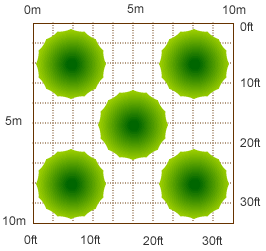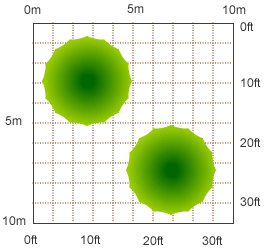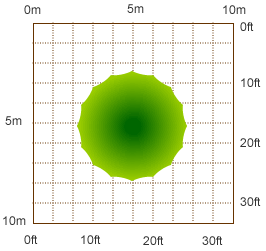This guide helps you to calculate the distances you should allow between your fruit trees. Spacings are primarily determined by the vigour of the rootstock you are using - from very-dwarfing rootstocks which produce very small trees, to very vigorous rootstocks which produce very large trees.
The 10m / 30ft lengths that we have used as examples are the same as two large estate cars parked nose to tail with a gap between them. There are further notes below the table.
Very-dwarf rootstocks
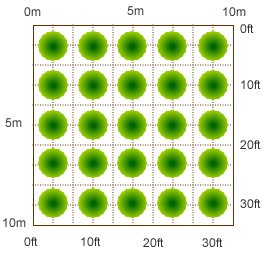
Available rootstocks:
Apple - M27Spacing
Distance between trees:1.5m
Spread:1.5mIt is easy to envisage how much space trees on very-dwarfing rootstocks will take up - it is about the same as a person with their arms slightly out-stretched.
Dwarf rootstocks
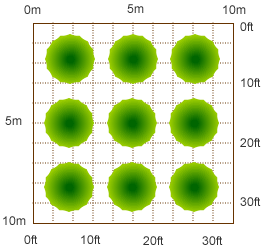
Available rootstocks:
Apple - M9
Pear - Quince ElineSpacing
Distance between trees:2.5m - 3m
Spread:2.5mThe apple M9 rootstock is very productive, the trees are small and easy to manage, and are capable of producing a lot of apples in a small space.
Semi-dwarf rootstocks
Semi-vigorous rootstocks
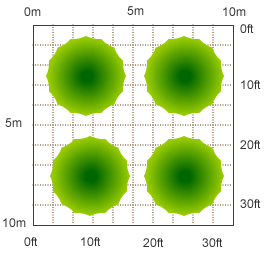
Available rootstocks:
Apple - M116, MM106
Plum - Wavit, Weiwa, St. Julien
Pear - Quince A
Cherry - Gisela 6Spacing
Distance between trees:3.5m - 4.5m
Spread:4mA good choice for the community orchard or for individual trees in a larger garden, and staking is not usually required once the trees are established.
Trees may be trained as either "bushes", with a shorter clear stem, or "half-standards", with a clear stem of about 1.2m-1.4m.
If space is tight you can use 3.5m between the trees if they are bush-trained, but a wider spacing is better for trees trained as half-standards.
Larger semi-vigorous rootstocks
Vigorous (standard) rootstocks
Notes
These spacings are just a rough guide, please contact us if you need further guidance.
Spacing between trees
In commercial orchards trees are often planted very close together to maximise the use of space, and many published guides use these commercial spacings.
In a garden situation things are not as clear-cut. Sometimes you want to know a precise spacing to fit a tree into an existing gap between other shrubs. Other times you may want to treat the spacings as a minimum, because you want the more spacious effect that comes with having a clear gap between your trees. In general very small trees will look equally good with or without space between the trees depending on the effect you want to achieve, whereas larger trees often look more of a feature if you have a space between them.
In either case, the spacing is measured from stem to stem of each tree. If planting several trees, mark the position of each tree with bamboo canes to check the spacing before you start to dig the holes.
Spacing between rows
Our diagrams are intended to illustrate the spacings in a garden situation where there is usually no need to differentiate the rows and columns of the planting pattern, and the main requirement is simply to see how many trees will fit in an available space.
If you are planting a small orchard then many other factors come into play. For example you will probably want to maintain a space between rows of trees for ease of access. As a rule of thumb this might be 1.5 x the spacing that you have chosen for trees within the row.
It is always a good idea to measure out your planting area, using bamboo canes to mark the desired spacings.
Vigour of the variety
Although the vigour of the rootstock has the biggest impact on the size of the mature tree and therefore the space it needs, the vigour of the grafted variety should also be taken into account. The table above assumes a variety of average vigour grown in reasonable soil conditions.
For vigorous varieties (such as the well-known Bramley apple) allow at least 10%-15% more space per tree.
For weak-growing varieties you can allow perhaps 10% less space per tree.
Trees growing in difficult conditions (e.g. poor soil, or windy sites) will also be smaller.

